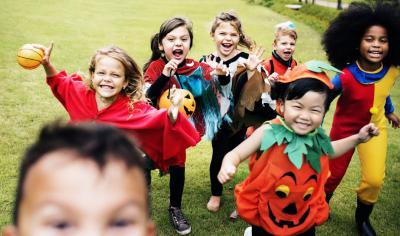Halloween Safety
Trick-or-treat! Princesses, Unicorns, Super Heroes and Ghosts, oh my! Halloween can be a very exciting time, for children and adults alike. However, many parents find there is a fine line between Halloween fun and concerns for their children’s safety.
According to the National Safety Council, children are more than twice as likely to be hit by a car on Halloween than any other day of the year. Now that’s scary!

The American Academy of Pediatrics and the Centers for Disease Control and Prevention (CDC) have compiled the following list of recommendations to ensure everyone has a festive AND safe Halloween holiday.
All dressed up
- Plan costumes that are light-colored, bright, reflective and flame retardant. Make sure shoes fit well and that costumes are short enough to prevent tripping, entanglement or contact with flame(s).
- Choose face paint, make-up and/or decorative hats whenever possible instead of full-faced masks, which can obstruct a child’s vision.
- Fasten reflective tape to costumes or bags and have children carry glow sticks or flashlights to help them see and be seen by drivers.
- Swords, knives and other costume accessories should be short, soft and flexible—a child can be easily hurt by accessories if they stumble or fall.
- Remove all make-up before children go to bed to prevent skin and eye irritation.
On the trail
- A parent or responsible adult should trick-or-treat along with children under age 12 years; if children are old enough (and mature enough) to be out without supervision, plan and review an acceptable route and advise them to stick to familiar areas that are well lit and to stay in groups. Also, agree on a specific time that their children should return home.
- Cross the street at corners, using traffic signals and crosswalks. Remember to look left, right and left again when crossing and continue looking as you cross. Never cut across yards or use alleys.
- Carry a cellphone for quick communication BUT put electronic devices down and keep head up when walking. Remind children to walk and not run and never dart out into the street or cross between parked cars.
- Remain on well-lit streets and use sidewalks or paths. If no sidewalk is available, walk at the far edge of the road facing traffic.
- Only go to homes with a porch light on and NEVER enter a home or a car for a treat.
- Don’t assume the right of way—motorists often have trouble seeing trick-or-treaters. Just because one car stops, doesn’t mean others will. Teach children to make eye contact with drivers BEFORE crossing in front of them.
- Tell your children not to eat treats until they return home.
Healthy Halloween
- Eat a good meal prior to parties and trick-or-treating to discourage children from filling up on Halloween sweets.
- Halloween can be tricky for children with food allergies—consider purchasing non-food treats for those who visit your home, such as coloring books or pens and pencils.
- Use party games and treat-or-treat time as an opportunity for children to get their daily dose of 60 minutes of physical activity.
- Wait until children are home to sort and check treats. Though tampering is rare, a responsible adult should closely examine all treats and throw away any spoiled, unwrapped or suspicious items.
- Teach children to politely turn down homemade goodies such as popcorn, cupcakes and brownies, and never taste or share another child’s treats.
- Try to ration treats for the days and weeks following Halloween.
Annapolis Pediatrics wishes everyone a safe and happy Halloween!
